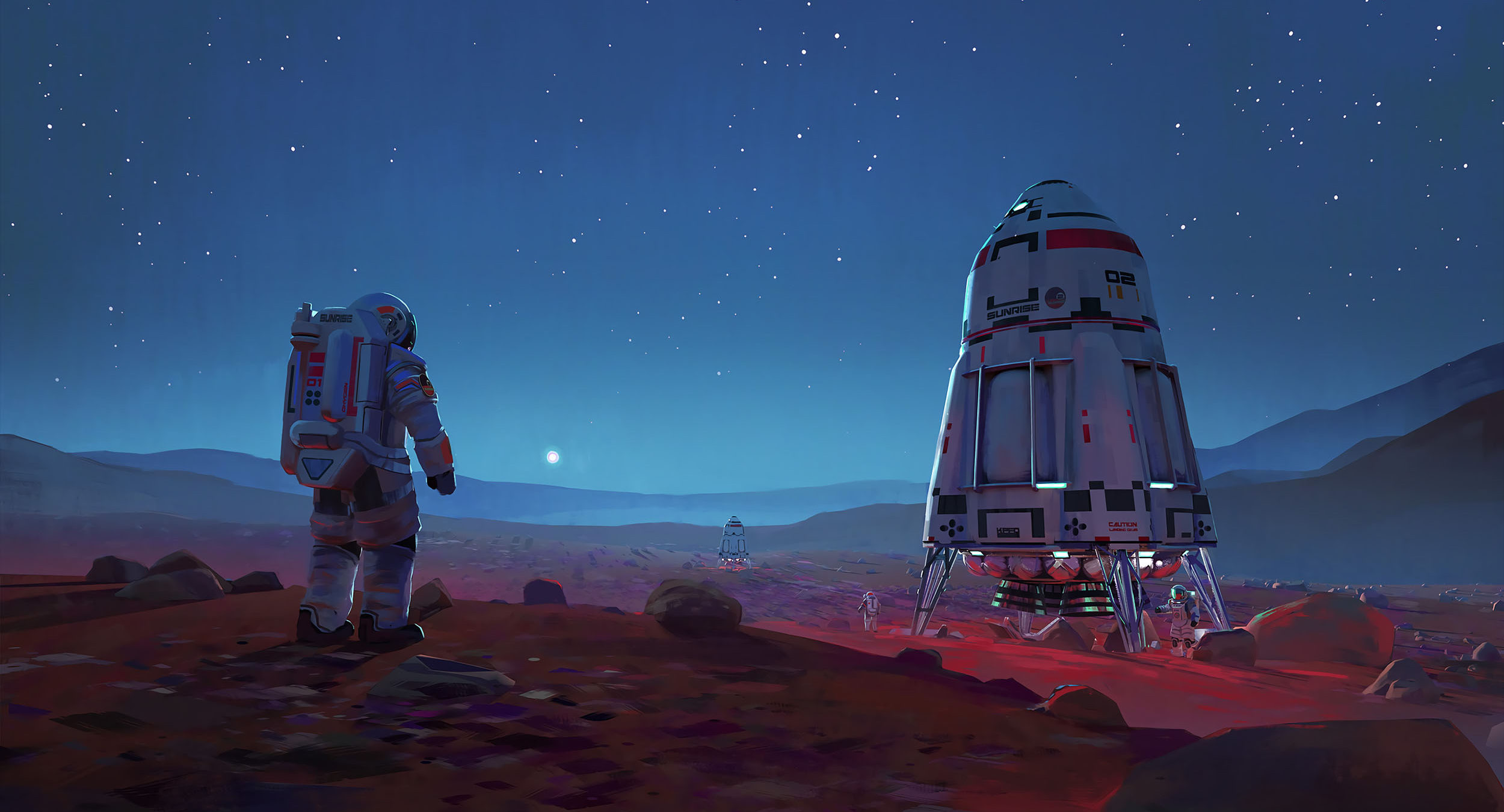“Why did I turn on the news today?” may be the most common refrain we hear today from just about everyone around us. We live in a world changing right before our eyes while being led by people who aren’t quite sure what happened in the last fifty years, but they definitely know they don’t like it and demand we turn back time. We can’t, of course, but that doesn’t appear to stop them from trying. So, it’s little wonder that we seem to be spinning our wheels and the news is filled with a seemingly incessant parade of horribles to such an extent that you’d be excused in thinking that reality was hijacked by a hack writer whose idea of plot progression are jump scares and endless cliffhangers.
So it’s in this spirit that over the years I’ve tried to switch things up a little and offer a sci-fi story instead of a new article about science, space, and technology every once in a while. It started out with chapters of a draft sci-fi novel I wrote back in the day. Then it transitioned into the three short stories published under the Sci-Fi Saturday rubric set in the same fictional universe. While they focused on some of the most common recurring topics on this site, there wasn’t any hidden point or grand plan behind them. I just wanted to give readers a break from reality if only for a bit and help them get lost in a different world.
Each time the feedback was generally positive, and the vast majority of criticism constructive and engaged. And over the past few weeks, this got me thinking. For the longest time, we’ve been told that serious examinations of our society comes from gritty melodramas, the type in which almost everybody dies tragic, exaggerated deaths or ekes out a bleak existence, walking everywhere uphill both ways, barefoot, eating bark and drinking sewage just to make it through the day. Movies based on these stories are often blatant Oscar bait relying on emotional gut punches as a proxy for substance the same way so many horror movies rely on jump scares as a substitute for genuine fear and dread.
Science fiction, on the other hand, was considered trivial pulp for nerds way too into rayguns and completely out of touch with real world concerns. But just consider the history of the genre. The so-called Golden Age of Sci-Fi ran from 1938 to 1946 and spanned the stubborn fight against the Great Depression, the rise of Nazi Germany, a world war, and the unveiling and use of humanity’s deadliest weapon. Its second wind saw the invention of computers, the start of the Cold War, and scientists and engineers laying the groundwork for the modern world, while the subsequent New Wave ruminated on the Civil Rights era, Mutually Assured Destruction, and humans walking on the Moon.
Its most notable examples offer deep meditations on where we’re headed and dove into the pressing issues of the day set against the backdrop of a future world that allowed us to focus on those concerns outside the confines of our current events so we could examine them from a new angle. Along the way, it inspired countless scientists and engineers to turn the amazing inventions they read about as kids into tools we take for granted today, and develop a passion for exploration and discovery that we desperately need to revive. And yes, a lot of these fictional future worlds involved rayguns, because rayguns are awesome, and don’t you let anyone tell you otherwise because they’re wrong.
Yes, science fiction is escapist entertainment that began as grandiose visions of the future by writers whose books are required reading in schools today, then popularized as pulpy comics and zines. But in its escapism lies its power. It lifts us out of the daily routine and preconceived notions of how the world is, and asks us to challenge our long held beliefs by playing them out or mocking them in a world by which we’re no longer tethered by our own inertia. When done right, it can inspire us to reconsider our own futures and to introduce new ideas, gadgets, and visions for where the world could go instead of where it is. And we need that inspiration today more than ever.
Now, with all that in mind, let’s return to Sci-Fi Saturday. If we need a place where we can escape the constant frustration of having leaders who think in 19th century terms about 21st century problems, to recharge, to visualize a new and very different future, why not here? Why not create a space where we don’t have to be confined by the news cycle and where we can combine some of the most interesting scientific and technical developments of out time, try to project them into the future, and see where we end up? So, like the World of Weird Things Podcast, Sci-Fi Saturday is going to become a recurring feature.

Of course, there’s a bit of a catch. I can’t write a 4,000 plus word story every week on top of all my writing and coding commitments unless this site were to become a once weekly hub for sci-fi instead of a popular science outlet, which very much runs contrary to the agenda laid out at the end of last year. But there is something I can do to ensure a weekly dose of escapism every week until the end of 2019 along with a steady stream of bleeding edge science and technology. Instead of resuming the sale of the aforementioned sci-fi novel Shadow Nation as an ebook, I’ll just be posting a chapter every week, from prologue to epilogue.
While the ebook did fine when it came up for sale, there were only so many copies I could realistically hope to sell without massive exposure among the tsunami of choices on Amazon, and the whole point of writing something is to have others read it, especially if it’s relevant to the kind of trends and ideas we’re seeing discussed today. Plus, as hinted before, the three Sci-Fi Saturday stories fit into the book’s universe, so if you liked them and were hoping for more context, you’re in luck and will see exactly how those stories fit into the fictional timeline.
The basic setup behind Shadow Nation is fairly simple. I assume that when we reach out in space, there won’t be a Galactic Federation of Planets to greet us and hand us a manual for how to be a spacefaring species because that’s probably impossible. Instead, we’ll be met by vast stretches of space populated by microbial life and very simple plants and animals at best, and advanced alien civilizations will be both few and far between, communicating by trade with the implied threat of force to make sure contracts are followed. Their goals might be hard for us to understand, their history obscure, and what drives them not always rational. And if we meet them, we might end up being pawns in their plans or an unintentional nuisance with all the consequences that will entail if we’re not careful.
Not only that, but extraterrestrial intelligence we will meet is likely to consist primarily of artificial probes and resilient cyborgs resembling Lovecraftian horrors rather than little green or gray men who either never invented clothes or wear shiny skin tight suits. Many of them might mean us no harm and may even want to keep their distance from us, but if we’re ever going to interact with them, we’ll want to take a cue from Teddy Roosevelt and speak softly with having a vast fleet of killer warships and nukes at our disposal should an encounter go horribly wrong.
Sure, it may sound unnecessarily militaristic, but if we have to do the same thing right here on Earth with other humans, it would be foolish to assume that aliens slighted by something we did or said couldn’t pose a serious threat. A religious hardliner on a mission could act on the advice of his religion’s representatives and offend an alien delegate by trying to convert its species to his faith. Or they could be infuriated if we refuse to convert to theirs, or be offended by our very existence since according to their beliefs, they are the pinnacle of life in the universe and have the license to conquer or eradicate “inferior organisms.” In short, our best case scenario is alien civilizations really not caring much about us or what we’re doing.
And, of course, there is also the issue of how scientifically accurate you want to be when it comes to sci-fi. Hard science fiction, or tales in which scientific accuracy is key to the story and serves as not just an accurate background for the sake of demonstrating an author’s research skills and knowledge about science and technology, but drives pivotal plot points, has quite a few fans. Just look at the success of Andy Weir’s work on The Martian and Artemis. But at the same time, there’s something to be said for bending the rules a little depending on what story you want to tell while keeping your characters and their motivations relatable.
For example, you can absolutely write space operas without warp drives or quantum magic to allow for instant communication in space. But if you’re describing an empire that stretches for hundreds of light years, you’ll be dealing with an environment in which every outpost is its own culture and mini-nation state, and instead of cohesive, centralized governorship, you end up with a loose confederacy only vaguely aware of what its members are doing and the members themselves unsure of developments outside of a sphere a few light years across, left to fend for themselves if something goes wrong.
The framework for the story you want to tell becomes a lot more limited, and it takes a rare gift to be able to craft a compelling space opera with multi-year gaps and a rotating cast of primary characters as the story unfolds, often requiring heavy exposition and protagonists having to be briefed on major conflicts and events that happened while they were frozen in cryonics, or end up carrying out their great-grandparents’ missions on a generation ship. Certainly there are those who understand how to craft such stories. Unfortunately for me, I don’t think I have the necessary ability, which is why I’m sticking to the tried and true warp-drives-exist-in-the-future approach, albeit putting my own twist on how it could work, though I also explore the light speed limited path for a little while.
The end result allows for the same cast of main characters, and big events unfolding quickly, without the need to set up exposition breaks, and maintain consistent cultures as far as the fictional universe is concerned. And most importantly, this works for the story I want to tell, a story of good intentions and conviction in one’s mission set against a stark background of that mission’s unintended and periodically bloody fallout. A story that doesn’t rotate around flawed good guys, scrappy antiheroes, or relatable evildoers whose actions you might find repellent but can rationalize, but one about making hugely consequential choices with imperfect information and under immense pressure, then being strapped in for the ride until the bitter end.

But enough about story mechanics. Let’s talk about the book itself and what you can expect with a brief synopsis of what you’ll be diving into. Our story begins in the early 2100s on Mars where Ace, a physicist working on building a permanent human habitat on the red planet, awakens to find himself face to face with mysterious alien creatures who inform him that he is dead before educating him about alien civilizations whose ruins dot the Milky Way, and testing his inquisitiveness. Apparently satisfied with his performance, they plunge Ace into a cave flooded with a black liquid that seems to have a mind of its own and gives the terrified astronaut a peek at the changes about to occur to him and his fellow crew members.
After this incident, all attempts to establish contact with the mission are in vain. The crew disappears without a trace. Life on Earth continues as usual until one day in 3507 when two alien spacecraft piloted by ravenous insect-like creatures land in an industrial center of one of the planet’s key hyper-cities. They’re quickly dispatched after a short firefight but the Earth’s ruling body led by Councilor Howard Grey and his second in charge, Councilor Andrew Newman, knows full well that these must be scouts, part of a much larger alien fleet that may be impossible to defeat even with their most advanced weapons.
But just as the councilors are planning their defense, an armada of sleek, heavily armed spacecraft easily beat back the insectoids’ incoming fleet and quickly hack into Earth’s most secure servers, hijacking the communication nodes used for top secret communication between the planet’s military and civilian leaders. However, they use their control of these nodes to share intelligence on the aliens they just defeated and introduce themselves to Earth’s leaders.
Ace, now a cyborg far more machine and alien than human, albeit resembling the human form in principle, introduces himself and tells the shocked International Council that the astronauts who went missing on Mars all those centuries ago were kidnapped and turned into test subjects for a species that calls itself The Dark Gods. Now, they control a vast territory of their own which they’ve named the Shadow Nation. They grew over centuries of extended warfare, becoming feared and powerful arms and high tech dealers to many of the galaxy’s space faring species.
Along the way, they made contact with humans sent on missions to explore other solar systems during a brief burst of exploration between 2359 and 2685 AD, and used their know how to turn them into cyborgs with superhuman abilities and nearly limitless life spans much like themselves. Despite the last few centuries of calm and prosperity, the Dark Gods are trying to break a peace and cooperation treaty meant to protect the Earth, fearing that the Shadow Nation is about to rise up and unseat them from their perch as the galaxy’s overlords.
Now, Earth find itself in the crossfire of a seemingly inevitable war and while Councilor Grey and his allies are excited about the opportunity to secure their political future to advance the planet by thousands of years by trading with the cyborgs, Councilor Newman takes a much dimmer view and quickly embraces a much darker view of why the Nation reached out to Earth. As the pitched battles between the Nation and the Dark Gods begin to rock the galaxy, Earth is itself locked in a struggle over what to do should the Nation’s forces lose the war, and whether it’s a good thing if they manage to win.
As the story unfolds, expect some supplementary posts exploring the real world science and technology referenced in the book, and showing how some seemingly impossible things that could only be built or tested thousands of years in the future are a lot closer than we might think, and the challenges they pose, as well the the opportunities they offer. As the cliche saying goes, the future waits for no one, and we’re currently seeing what happens when we take our eye off the road ahead for a few decades, assuming that we have a good handle on everything, and we’re ready to tackle any challenge that comes our way.
But most importantly, I hope you check in and enjoy the weekly installments as they come out, and this story makes you think and ask where we want to go as a civilization. How would we recapture the spirit of exploration and discovery that sent us wandering across the world many times over for tens of thousands of years, and led us to start launching probes to other planets and their moons? Or should we stay put rather than risk the dark, potentially hostile unknown? These aren’t rhetorical questions. And someday soon, we’ll need to answer them.






